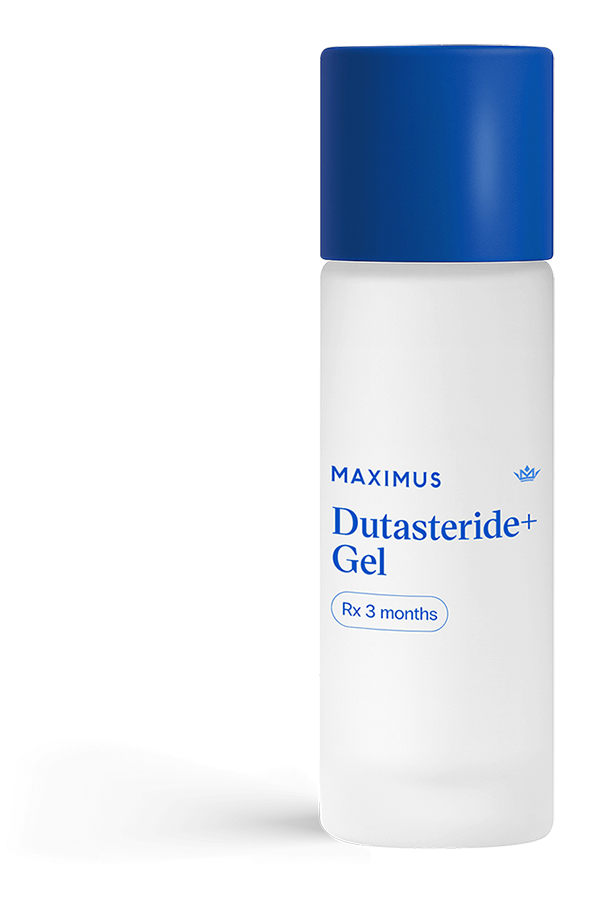Topical Dutasteride
Maximus' Topical Dutasteride: Systemic Absorption and Side Effect Profile in Androgenetic Alopecia

Gabriel Alizaidy, M.D., M.S.1; S. Cameron Sepah, Ph.D.1,2; Starling Krentz, M.S.1
1. Maximus, Los Angeles, CA, United States
2. University of California, San Francisco, Department of Psychiatry, San Francisco, CA, United States
Corresponding Author:
S. Cameron Sepah, Ph.D.
Email: cam@maximustribe.com
Abstract
Background: Oral dutasteride is a potent 5-alpha reductase inhibitor that reduces serum dihydrotestosterone (DHT) by up to 95%. While effective for androgenetic alopecia (AGA), its high level of systemic DHT suppression is associated with potential side effects. Topical finasteride has been used in an attempt to lower systemic exposure, but published studies show that it still significantly reduces serum DHT. Dutasteride, due to its larger molecular weight, is less likely to penetrate the skin without assistance. The MaxAbsorb delivery system was developed to enhance scalp delivery of topical dutasteride while limiting systemic absorption.
Objective: To evaluate the systemic hormone impact and side effect profile of topical dutasteride delivered with MaxAbsorb.
Methods: Fifteen male participants aged 27 to 66 applied a compounded topical formulation containing 0.1% dutasteride once daily for at least 30 days. Hormone levels (DHT, total testosterone, estradiol, SHBG) were measured before and after treatment. Participants also completed validated self-assessment questionnaires (QADAM and PHQ-4) along with additional lifestyle and quality-of-life items. Pre- and post-treatment values were compared using paired t-tests.
Results: Serum DHT decreased by 20.40%, with no significant changes in testosterone, estradiol, or SHBG. No participants reported sexual, mood, or cognitive side effects typically linked to systemic 5-alpha reductase inhibitors. Instead, participants reported statistically significant improvements in libido (p = 0.0280), strength (p = 0.0016), and enjoyment of life (p = 0.0462). Erection quality remained stable. PHQ-4 mood scores and lifestyle metrics including physical activity and focus also improved, though not all changes reached statistical significance.
Conclusion: Topical dutasteride with MaxAbsorb limits systemic hormone disruption while improving quality-of-life measures and avoiding side effects commonly seen with oral treatments. This formulation offers a practical and well-tolerated alternative to oral and topical finasteride for men seeking a safer option in the management of AGA.
↔
Reports of sexual, mood, or cognitive side effects
↓
Decrease in serum DHT levels with 0.1% topical dutasteride
Background
Oral dutasteride is one of the most effective medications for lowering dihydrotestosterone (DHT), with studies showing up to a 95% reduction in serum levels.1 It has also demonstrated greater efficacy than finasteride in treating male androgenetic alopecia.2 This superior performance is attributed to its stronger and more comprehensive suppression of type I and type II 5-alpha reductase enzymes.
Although highly effective, oral dutasteride is generally well tolerated, especially when compared to other commonly used 5-alpha reductase inhibitors such as finasteride. A systematic review found that while both drugs can cause sexual side effects, the relative risk was higher with finasteride (1.66) compared to dutasteride (1.37), and the increase associated with dutasteride was not statistically significant.3
Finasteride is sometimes used topically rather than orally in an attempt to limit systemic DHT suppression, which may be linked to side effects in some patients. However, despite being applied to the skin, topical finasteride still reduces serum DHT to a significant degree. One study reported a 34.5% reduction in serum DHT compared to 55.6% with oral use, while another found topical and oral finasteride to be nearly equivalent in this respect, with reductions of 75 and 72%, respectively.4,5 This systemic absorption is likely due to finasteride’s relatively low molecular weight of 372.5 g/mol, which allows it to cross the skin barrier more easily.6
In contrast, dutasteride has a larger molecular weight of 528.5 g/mol, which places it above the commonly referenced 500 Dalton rule for transdermal drug absorption.7,8 This suggests that without the aid of permeation enhancers, dutasteride may not readily penetrate the skin. Our MaxAbsorb delivery system was developed to address this challenge by enhancing localized uptake through the scalp while limiting systemic exposure.
Objective
This study was designed to evaluate whether topical dutasteride, when delivered using MaxAbsorb, could achieve scalp-level effects while minimizing systemic absorption. The primary focus was to assess the extent of change in serum DHT levels and the incidence of side effects typically seen with oral 5-alpha reductase inhibitors, including alterations in libido, mood, and sexual function.
Methods
We conducted a single-arm, open-label study involving fifteen male participants between the ages of 27 and 66. Participants were on a variety of existing Maximus treatment protocols at the time of enrollment, including combinations of enclomiphene and topical testosterone, oral testosterone, injectable testosterone, or no testosterone-related therapies. Two participants were not using any testosterone products.
The trial required a minimum participation period of 30 days. Each participant was instructed to apply a compounded topical solution to the scalp once daily. The formulation contained 0.1% dutasteride, 0.01% tretinoin, 5% minoxidil, 0.1% fexofenadine, 0.0033% melatonin, and 0.2% caffeine in the MaxAbsorb permeation enhancer base.
Blood samples were collected at baseline and after the treatment period to measure serum DHT, total testosterone, estradiol, and SHBG. Participants also completed two validated self-assessment tools: the Quantitative Androgen Deficiency in the Aging Male (qADAM) questionnaire for quality-of-life evaluation, and the Patient Health Questionnaire-4 (PHQ-4) for screening depression and anxiety symptoms. In addition to these standardized measures, participants reported on lifestyle and health habits, including average sleep duration, physical activity levels, diet quality, attention and focus, and relationship satisfaction.
Paired t-tests were used to compare pre- and post-treatment values. A p-value of less than 0.05 was considered statistically significant.
Results
Topical dutasteride reduced serum DHT by 20.40%, from 109.13 to 86.87 ng/dL, which was not statistically significant (p = 0.4577). This reduction was substantially lower than the 90 to 95% typically observed with oral administration. Total testosterone increased by 15.45% (p = 0.5503). Estradiol and SHBG remained stable, with p-values of 0.9997 and 0.8007, respectively.
Changes in Serum Hormone Levels
| Hormone | Before | After | Change | % Change | p-value |
|---|---|---|---|---|---|
| DHT | 109.13 | 86.87 | -22.27 | -20.40% | 0.4577 |
| Total Testosterone | 801.67 | 925.53 | 123.87 | 15.45% | 0.5503 |
| Estradiol | 46.6 | 46.73 | 0.13 | 0.29% | 0.9997 |
| SHBG | 32 | 30.93 | -1.07 | -3.33% | 0.8007 |
Libido improved by 10.91%, and this change was statistically significant (p = 0.0280). Erection quality showed no meaningful change, with a 1.72% increase (p = 0.8544), indicating no adverse effect on sexual function.
Statistically significant improvements were seen in strength and endurance, which increased by 16.36% (p = 0.0016), and in enjoyment of life, which improved by 13.79% (p = 0.0462). Positive trends were observed in energy (10.53% increase, p = 0.1465), happiness (12.28% increase, p = 0.0849), and work performance (12.28% increase, p = 0.0849), although these did not reach statistical significance.
Changes in qADAM Quality-of-Life Measures
| qADAM Item | Before | After | Change | % Change | p-value |
|---|---|---|---|---|---|
| How would you rate your energy level? | 3.8 | 4.2 | 0.4 | 10.53% | 0.1465 |
| How would you rate your strength/endurance? | 3.67 | 4.27 | 0.6 | 16.36% | 0.0016* |
| How would you rate your enjoyment of life? | 3.87 | 4.4 | 0.53 | 13.79% | 0.0462* |
| How would you rate your happiness level? | 3.8 | 4.27 | 0.47 | 12.28% | 0.0849 |
| How would you rate your libido (sex drive)? | 3.67 | 4.07 | 0.4 | 10.91% | 0.0280* |
| How strong are your erections? | 3.87 | 3.93 | 0.07 | 1.72% | 0.8544 |
| How would you rate your work performance since starting the trial? | 3.8 | 4.27 | 0.47 | 12.28% | 0.0849 |
| How often do you fall asleep after dinner without intending to? | 1.27 | 1.13 | -0.13 | -10.53% | 0.3673 |
| How would you rate your sports ability? | 3.6 | 3.8 | 0.2 | 5.56% | 0.2097 |
Note: All items were rated on a scale of 1–5, where a higher score indicates improvement, except for "How often do you fall asleep after dinner without intending to?" where a lower score indicates improvement.
All four PHQ-4 mental health items improved from baseline to the end of the treatment period. Nervousness and anxiety decreased by 24.81% (p = 0.1141), uncontrolled worrying decreased by 16.67% (p = 0.2097), depressed mood decreased by 24.81% (p = 0.1141), and anhedonia decreased by 19.05% (p = 0.1141). While none of these changes were statistically significant, all moved in a favorable direction.
Changes in PHQ-4 Mood and Anxiety
| PHQ-4 Item | Before | After | Change | % Change | p-value |
|---|---|---|---|---|---|
| Days bothered by feeling nervous, anxious, or on edge | 1.33 | 1 | -0.33 | -24.81% | 0.1141 |
| Days bothered by not being able to stop or control worrying | 1.2 | 1 | -0.2 | -16.67% | 0.2097 |
| Days bothered by feeling down, depressed, or hopeless | 1.33 | 1 | -0.33 | -24.81% | 0.1141 |
| Days bothered by having little interest or pleasure in doing things | 1.4 | 1.13 | -0.27 | -19.05% | 0.1141 |
Note: For PHQ-4 items, lower scores mean fewer days with symptoms, so a negative change reflects improvement.
Lifestyle and health habit measures showed modest improvements. Attention and focus improved by 9.26% (p = 0.149), relationship quality by 7.41% (p = 0.3673), and diet quality by 5.26% (p = 0.4087). Physical activity increased by 31.72%, from 4.83 to 6.37 hours per week (p = 0.3006). Average sleep duration remained unchanged at 7 hours (p = 1.0).
Changes in Lifestyle and Health Habit Measures
| Lifestyle & Health Habits Item | Before | After | Change | % Change | p-value |
|---|---|---|---|---|---|
| How many hours of sleep do you average per night? | 7 | 7 | 0 | 0.00% | 1 |
| How many hours of moderate-to-vigorous physical activity do you do per week? | 4.83 | 6.37 | 1.53 | 31.72% | 0.3006 |
| How would you rate the quality of your diet/nutrition? | 3.8 | 4 | 0.2 | 5.26% | 0.4087 |
| How would you rate your ability to sustain attention/focus? | 3.6 | 3.93 | 0.33 | 9.26% | 0.149 |
| How would you rate the quality of your relationships? | 3.6 | 3.87 | 0.27 | 7.41% | 0.3673 |
Conclusion
This study suggests that topical dutasteride, when delivered using the MaxAbsorb system, achieves successful scalp permeation while limiting systemic absorption. Serum DHT levels decreased by approximately 20%, supporting the hypothesis that dutasteride’s larger molecular structure, even with enhanced delivery, results in far less systemic exposure compared to oral administration.
In a recent randomized, double-blind, controlled trial, Panuganti and colleagues reported that a 0.05% dutasteride topical solution produced significant improvements in hair density and thickness compared with placebo and oral finasteride.9 Their solution contained only half the concentration of dutasteride used in our formulation, yet it still demonstrated clear efficacy. These findings strengthen the rationale for topical dutasteride and support the potential of our higher-strength MaxAbsorb system. As patient use expands, we plan to share outcomes that build on the safety and quality-of-life improvements already observed.
These findings highlight the potential of this approach for individuals seeking to minimize systemic DHT suppression that often occurs with oral dutasteride, oral finasteride, and even topical finasteride. This formulation may offer a favorable balance by maximizing the local therapeutic benefits of dutasteride while avoiding the broader hormonal impact seen with other 5-alpha reductase inhibitors.
Participants did not report the side effects typically associated with oral medications that exert a greater impact on systemic DHT levels. Instead, improvements were observed in libido, physical strength, and overall enjoyment of life, with erection quality remaining stable. Mood and anxiety scores on the PHQ-4 also moved in a favorable direction.
While not every outcome reached statistical significance, the consistent direction of change across multiple measures reinforces the goal of reducing systemic exposure without compromising quality of life. For individuals prioritizing safety, tolerability, and localized efficacy, these results support topical dutasteride with MaxAbsorb as a practical and powerful alternative to current oral and topical therapies.
References
- Clark RV, Hermann DJ, Cunningham GR, Wilson TH, Morrill BB, Hobbs S. Marked suppression of dihydrotestosterone in men with benign prostatic hyperplasia by dutasteride, a dual 5alpha-reductase inhibitor. J Clin Endocrinol Metab. 2004;89(5):2179-2184. doi:10.1210/jc.2003-030330
- Choi GS, Sim WY, Kang H, et al. Long-Term Effectiveness and Safety of Dutasteride versus Finasteride in Patients with Male Androgenic Alopecia in South Korea: A Multicentre Chart Review Study. Ann Dermatol. 2022;34(5):349-359. doi:10.5021/ad.22.027
- Lee S, Lee YB, Choe SJ, Lee WS. Adverse Sexual Effects of Treatment with Finasteride or Dutasteride for Male Androgenetic Alopecia: A Systematic Review and Meta-analysis. Acta Derm Venereol. 2019;99(1):12-17. doi:10.2340/00015555-3035
- Piraccini BM, Blume-Peytavi U, Scarci F, et al. Efficacy and safety of topical finasteride spray solution for male androgenetic alopecia: a phase III, randomized, controlled clinical trial [published correction appears in J Eur Acad Dermatol Venereol. 2023 Feb;37(2):452. doi: 10.1111/jdv.18750.]. J Eur Acad Dermatol Venereol. 2022;36(2):286-294. doi:10.1111/jdv.17738
- Caserini M, Radicioni M, Leuratti C, Annoni O, Palmieri R. A novel finasteride 0.25% topical solution for androgenetic alopecia: pharmacokinetics and effects on plasma androgen levels in healthy male volunteers. Int J Clin Pharmacol Ther. 2014;52(10):842-849. doi:10.5414/CP202119
- National Center for Biotechnology Information. PubChem Compound Summary for CID 57363, Finasteride. https://pubchem.ncbi.nlm.nih.gov/compound/Finasteride. Accessed May 19, 2025.
- National Center for Biotechnology Information. PubChem Compound Summary for CID 6918296, Dutasteride. https://pubchem.ncbi.nlm.nih.gov/compound/Dutasteride. Accessed May 19, 2025.
- Bos JD, Meinardi MM. The 500 Dalton rule for the skin penetration of chemical compounds and drugs. Exp Dermatol. 2000;9(3):165-169. doi:10.1034/j.1600-0625.2000.009003165.x
- Panuganti V, Kumar Madala P, Ramalingayya Grandhi V, et al. A randomized, double-blind, placebo and active controlled phase II study to evaluate the safety and efficacy of novel dutasteride topical solution (0.01%, 0.02%, and 0.05% w/v) in male subjects with androgenetic alopecia. Cureus. 2025;17(8):e89309. doi:10.7759/cureus.89309






